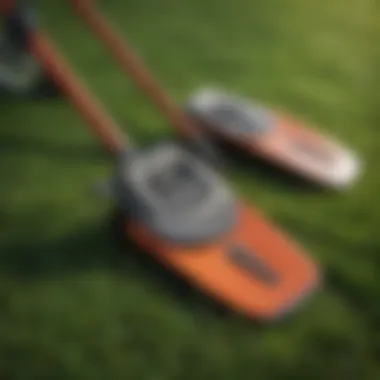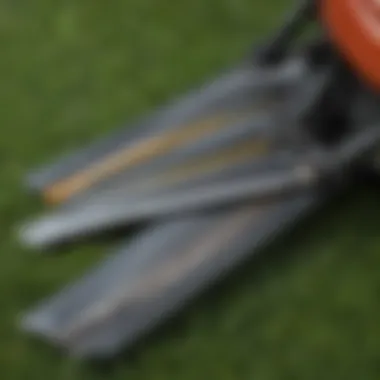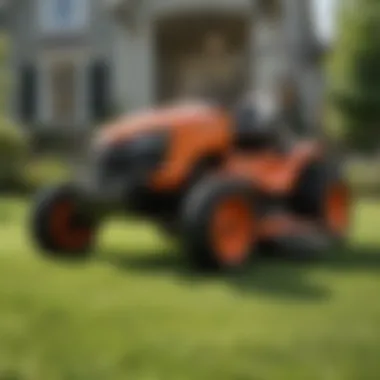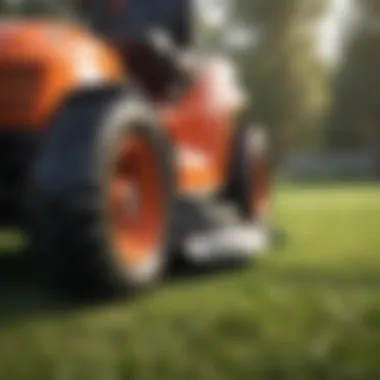The Ultimate Guide to Selecting Lawn Mower Blades


Overview of Topic
When it comes to lawn care, the importance of lawn mower blades can't be overstated. Think of the blades as the unsung heroes of your mower, quietly working behind the scenes to transform your garden into a manicured masterpiece. The specific topic of lawn mower blades has significant implications within the home improvement sphere, especially for homeowners seeking to maintain a lush and vibrant lawn.
Crummy blades can lead to ragged grass edges, leaving your lawn looking shabby and vulnerable to diseases. A sharp and appropriately chosen blade, on the other hand, plays a pivotal role in cutting cleanly and efficiently. These blades come in different shapes and sizes, tailored to various mowing needs, which is essential to consider when choosing the right tool for your lawn.
Importance of the Topic
Using the right mower blades can enhance the performance of your mower while reducing your work. Homeowners tend to overlook this aspect, but ensuring that your blades are suited to your grass type and mowing conditions can save a lot of time and hassle. Selecting the best blades is like picking the right shoes for a particular occasion; it vastly improves the experience. Beyond performance, proper blades support a healthier lawn, making this topic crucial for anyone invested in their garden’s appearance and vitality.
Common Challenges and Solutions
Maintaining a lawn isn’t without its hiccups. Here are some common challenges homeowners face regarding lawn mower blades, along with insights on how to tackle them:
- Dull Blades: Over time, blades dull due to wear and tear, leading to an uneven cut.
- Incorrect Blade Type: Using the wrong blade type can hinder mowing efficiency.
- Installation Issues: Sometimes homeowners struggle with getting the blades installed correctly.
- Solution: Regularly sharpen your blades, ideally at least once a season, to maintain optimal cutting performance.
- Solution: Understand the type of grass you have and choose corresponding blades. For example, a high-lift blade might work better for tall grass while a mulcher blade can be perfect for fine grass.
- Solution: Follow your mower’s manual for precise installation instructions, and watch video tutorials for visual guidance.
"Choosing the right lawn mower blade is like finding a perfectly tailored suit. It can make all the difference in performance and appearance."
Product Recommendations
Choosing the right blades can be a daunting task given the plethora of options available on the market. Let’s take a closer look at some top contenders:
- MaxPower 331813XB: Known for its durability, this blade enhances cutting efficiency for rotary mowers. It’s a versatile option, suitable for various grass types.
- Oregon G3: A phenomenal choice for mulching, the Oregon G3 blades finely chop grass clippings, returning nutrients to your lawn.
- Exmark 103-1340: Ideal for those with commercial-grade needs, these blades create a clean cut and have a longer lifespan, making them a worthy investment.
Each of these products brings unique benefits and features, catering to different mowing needs and preferences.
Step-by-Step Guides
If you're itching to improve your lawn care routine, here’s a simple guide to help you through the process:
- Assess Your Lawn: Identify the grass type and the typical height it grows to determine which blade would suit best.
- Choose the Right Blade: Based on your assessment, select a blade designed for your lawn’s specific requirements.
- Sharpen or Replace: Inspect your current blades closely. If they are past their prime, consider getting new ones or sharpening them if that’s feasible.
- Follow Installation Instructions: Safely detach the old blades and install the new or sharpened ones, ensuring they are securely fastened.
- Test the Mower: After installation, do a test run to evaluate the cutting performance and make adjustments if needed.
By following these steps, you'll ensure that your mower operates like a well-oiled machine, allowing you to enjoy a picturesque lawn all season long.
Intro to Lawn Mower Blades
Understanding lawn mower blades is more than a mere technical examination of a tool. It’s about recognizing how critical these components are to maintaining a healthy lawn. The blade plays an integral role in shaping not just the appearance but the overall health of your grass. Well-chosen blades can mean the difference between a flourishing green space and a patchy, unhealthy yard.
Importance of Lawn Mower Blades
Lawn mower blades are fundamental to effective grass cutting. The right blade will ensure clean cuts, which promotes grass health, while a dull or inappropriate blade can tear and damage grass, leading to disease and poor growth. Think of it as a haircut; a clean cut allows hair to grow back nicely, while a botched style can lead to unevenness and damage.
Moreover, the choice of blade influences how often one must mow the lawn. Dull blades require more passes, while sharp blades cut smoothly and efficiently. Choosing the right blades also means understanding specific needs based on grass type, terrain, and mower type, which we shall explore.
Overview of Lawn Mower Types
Different types of lawn mowers manage grass in unique ways. Each type has its own set of advantages and disadvantages, determined largely by their design and intended use.
Gas-Powered Mowers
Gas-powered mowers are the workhorses of the mowing world, often celebrated for their robustness and cutting power. They can handle tough terrains and thick grass without breaking a sweat. These mowers have the capability to operate over large areas without the need for being tethered to an electrical source, providing unparalleled freedom. A gas mower's key characteristic lies in its engine power, which often results in them being a favorite for homeowners with expansive lawns.
Nevertheless, they come with drawbacks, such as noise and emissions, making them less ideal for those who seek an environmentally-friendly option. Furthermore, they require regular maintenance and fueling, which can be burdensome for the casual user.
Electric Mowers
Electric mowers, available in both corded and cordless models, have gained popularity for their ease of use and quieter operation. Their lightweight design often makes them easier to maneuver and store, appealing greatly to homeowners with smaller yards. These mowers are generally lower maintenance since they don’t require oil changes or fuel.
A significant feature of electric mowers is their eco-friendliness. They produce zero emissions during operation, aligning with the growing trend toward sustainability in yard care. However, electric mowers can struggle with thick or wet grass, and their runtime is limited by battery life unless plugged in.
Robotic Mowers


Robotic mowers represent the cutting edge of lawn care technology, taking convenience to a whole new level. These automated machines can mow while you attend to other tasks, providing a hands-off experience. The key trait of robotic mowers is their programmed navigation, which allows them to mow efficiently and return to their charging stations when needed. For busy homeowners, this represents a dream come true—grass cutting without any manual effort.
However, they may not handle uneven terrain well and tend to have higher upfront costs compared to traditional mowers. Furthermore, a reliable power supply is crucial for their performance, limiting some use cases.
"In choosing a lawn mower, remember: the blade is sometimes the unsung hero of maintaining a beautiful yard."
The selection of mower types sets the stage for understanding how different blades will function, as each mower’s capabilities dictates the types of blades best suited for it. Knowing the nuances of each mower allows homeowners to make informed decisions, ensuring optimal grass health and appearance.
Types of Lawn Mower Blades
Understanding the various types of lawn mower blades is crucial for anyone looking to keep their lawn in tip-top shape. Different blades serve distinct purposes, and the right choice can make all the difference in achieving that perfect cut and keeping the grass healthy. Whether you're a weekend warrior in the garden or a homeowner dedicated to a flawless lawn, learning about the types of blades available equips you with the knowledge needed to opt for the most effective cutting option.
Standard Blades
Design Features
Standard blades, often regarded as the go-to option for many lawn care enthusiasts, sport a simple yet effective design. They typically feature a straight edge that strikes a balance between width and length, making them versatile enough for a variety of grass types. The key characteristic of these blades lies in their balanced structure that provides a clean cut without tearing the grass.
This is particularly beneficial if your goal is to maintain a tidy lawn without excessive wear or tear on your grass. A notable benefit is the ease of maintenance; standard blades can usually be sharpened without the need for specialized tools.
Suitable Grass Types
The flexibility of standard blades extends to the types of grass they can handle. They're particularly adept at mowing common grass species like Kentucky bluegrass, fescue, and ryegrass. One of the unique features of standard blades is their adaptability—they're effective across various conditions and are seen as a popular choice for general home use. While they provide a good cut for many grass types, they might struggle a bit with taller varieties or heavy weeds, which can lead to less-than-ideal results if not mowed regularly.
Mulching Blades
Benefits of Mulching
Mulching blades carry a distinct edge, pun intended, as they are specifically designed for creating finely chopped grass clippings that can be recycled back into the lawn. Not only does this enrich the soil, but it also aids in moisture retention. One of the standout characteristics is the curved design that increases the time clippings remain within the blade area, ensuring they are cut down into smaller pieces. This can greatly benefit your lawn by providing nutrients and improving overall health. However, they may require more frequent cleaning to prevent buildup, especially in wet conditions.
Performance Characteristics
When it comes to performance, mulching blades excel at ensuring the grass is finely shredded. Grass clippings are smaller, leading to reduced thatch buildup which can suffocate the grass beneath. This performance aspect is crucial for maintaining a lush lawn. However, for homeowners who prefer a very tidy look, the resulting mulched grass may not always live up to that aesthetic, as it can create a bit of a messy appearance immediately after mowing.
High-Lift Blades
Airflow Dynamics
High-lift blades are engineered to create a remarkable airflow that significantly raises the grass as it is cut. The upward lift generated by these blades is beneficial, especially in areas with thicker grass. A key benefit of their design is that they are superb at projecting clippings further away from the mower, which reduces the amount of clumping on the lawn. However, this powerful airflow means they might require a bit more horsepower from your mower, which can lead to increased fuel consumption.
Best Applications
These blades shine in certain applications, particularly when dealing with tall or thick grass. High-lift blades can be particularly effective in spring or after a significant rainfall when grass tends to grow rapidly. On the flip side, they may not be ideal for every situation; in dry conditions or with lighter grass, the high lift can lead to excessive clipping discharge, resulting in a messy lawn finish.
Low-Lift Blades
Efficiency Considerations
Low-lift blades differ from their high-lift counterparts by providing a cut that stays closer to the ground. Their design is less aggressive, which can lead to increased efficiency, especially for lighter grasses. The primary advantage is their ability to conserve energy, making them suitable for electric mowers or smaller gas mowers, which require less power to operate.
Ideal Uses
These blades are perfect for maintaining shorter grasses and are often recommended for homeowners who prefer a well-manicured lawn without needing to mow as frequently. Their unique feature of reducing the likelihood of clogs in the mower makes them a solid choice for mowing low-growing grass types. However, they may not stand up well against thicker or taller grasses, where they might simply push the grass over rather than making a clean cut.
Materials Used in Lawn Mower Blades
Understanding the materials used in lawn mower blades is crucial for any homeowner or lawn care enthusiast. The wrong choice of blade material can affect performance, longevity, and even safety. Steel and composite materials dominate this landscape, each with distinct characteristics that cater to different mowing needs. Let's delve into the specifics of these materials to help you make an informed choice.
Steel Blades
Characteristics of Steel
When talking about lawn mower blades, steel stands out as a traditionally favored material due to its strength and sturdiness. Steel blades are commonly made from high-carbon steel, which is known for its hardness. This characteristic alone makes steel blades resilient and able to maintain a sharp edge longer than many alternatives. Moreover, steel can hold up well against various terrain obstacles, from twigs to tougher grass types, providing reliability during mowing sessions.
One unique feature of steel blades is their ability to be sharpened. Quite simply, with the right tools, you can restore the cutting edge of a steel blade, extending its life significantly. However, it’s important to note that they do require regular maintenance to keep them in top shape. This commitment to upkeep is what makes them a popular choice for those who prioritize durability and performance in their lawn care routine.
Durability and Maintenance
Durability is one of the top selling points of steel blades. They are built to withstand a battering. Homeowners who frequently mow grassy patches filled with stones or rugged landscapes will find steel blades particularly advantageous. Another benefit is their resistance to oil and fuel. In contrast to some composites, steel can endure exposure to these substances without deteriorating.


However, the downside is that steel blades can be prone to rust if not properly cared for. It's essential to dry the blades after use and store them in a dry area. If you neglect this, a rusty blade can lead to poor performance and, frankly, ruin your mowing job. Therefore, while they offer great durability, the maintenance aspect should not be overlooked. Balancing these factors is key in deciding whether steel blades fit your lawn care needs.
Composite Blades
Research on Composites
Composite blades are making waves as a modern alternative to traditional steel blades. They are made from high-strength plastic and reinforced with materials like carbon fiber. The ongoing research in this area highlights their growing popularity due to innovative composite technologies that enhance performance while being lightweight.
A key characteristic of composite blades is that they tend to be lighter than steel blades, making them easier to handle and maneuver for extended periods. For homeowners looking for less physical strain while mowing, composite blades are worth considering.
Nevertheless, one disadvantage is their susceptibility to wear and tear under heavy use. While they work great on normal grass and light foliage, tougher cutting jobs might not be where they shine.
Weight and Handling Benefits
The weight and handling benefits of composite blades add to their appeal, especially for occasional users or those with smaller yards. Because of their reduced weight, they can help achieve a smoother experience without requiring as much force or stamina.
Another advantage is their lower vibration levels during operation. This can mean a more pleasant mowing experience with reduced wear on your mower and less fatigue on your hands and arms when compared to heavier steel blades. However, they often require more frequent replacements, which could impact long-term cost efficiency for some users.
Performance Characteristics of Lawn Mower Blades
When it comes to getting your lawn looking its best, the performance characteristics of lawn mower blades play a pivotal role. These characteristics dictate how efficiently a mower cuts grass, affecting not only the aesthetics of your yard but its health, too. Understanding these aspects goes beyond mere mowing; it’s about fostering a resilient lawn ecosystem right from the get-go.
Cutting Height Adjustments
Impact on Lawn Health
One might wonder why cutting height adjustments matter so much. The height at which you mow your grass can either promote dense growth or lead to a patchy, sickly look. Keeping the grass at the right height allows it to photosynthesize effectively, ensuring robust development. Higher cuts can help shade the roots from the sun, retaining moisture and encourage deep root systems. However, overly tall grass might become a haven for pests or promote fungal diseases.
The preferred height for most grass types typically lies between two and four inches. This strikes a balance, allowing the grass to stay healthy while minimizing weed growth. Remember, a well-kept lawn does not just look good – it contributes to the overall environment by absorbing carbon dioxide and providing oxygen. In contrast, mowing too low can scalp the lawn, leaving it vulnerable and ragged. Maintaining a proper mowing height is therefore a beneficial choice for achieving a lush landscape.
Recommended Heights for Grass Types
Different grasses have different cutting height preferences. For instance, Kentucky Bluegrass thrives when cut between two and three inches, while Bermuda grass can handle being mowed a bit shorter, around one and a half to two inches. These specific recommendations exist because each grass type has adapted to absorb sunlight and moisture most effectively at its ideal height. Moreover, taller grass can help outcompete weeds, which like shorter, less established plants.
It’s also worth noting that seasonal changes play a vital role. In the cooler months, allowing grass to grow a bit taller can protect roots from frost. Conversely, during the heat of summer, too much length might invite pests or diseases. Hence, adjusting heights based on the season is a key characteristic to keep in mind, making it a significant factor in your lawn care routine.
Sharpness and Maintenance
Importance of Sharp Blades
The sharpness of your lawn mower blades can’t be overstated. Dull blades rip and tear grass rather than slicing cleanly, which can lead to frayed edges and, ultimately, a brownish hue. These brown edges not only make the lawn look unhealthy, but they also open the door to disease. Sharp blades, on the other hand, create clean cuts, promoting faster recovery and less stress on the grass.
Regularly checking and sharpening blades is an essential practice. This attention to detail not only enhances mower performance but also extends its life, as sharper blades can lessen the strain on the mower's engine. A little bit of upkeep goes a long way in preserving your equipment while ensuring a pristine lawn.
Sharpening Techniques and Tools
So, how do you keep those blades razor sharp? There are several methods available. You can use a whetstone for a more hands-on approach, or a bench grinder for quicker results. For those less inclined towards DIY, many local lawn care services can sharpen your blades for a small fee.
It's smart to check the blades at least once a season, or even more often if conditions warrant it. Not only can a sharp blade make mowing easier, but it can also lead to a healthier lawn overall. Finding a suitable maintenance routine can be the difference between a patchy, unhealthy yard and a lawn that’s the envy of the neighborhood.
"A sharp blade is not just a tool; it’s an investment in your lawn's health."
In summary, understanding the performance characteristics of lawn mower blades means recognizing the intricacies that contribute to a healthy and vibrant lawn. From mowing heights to blade sharpness, every detail counts. Whether you are a seasoned pro or a newcomer to lawn care, these elements are fundamental to keeping your outdoor space looking its best.
Choosing the Right Lawn Mower Blade
Choosing the right lawn mower blade is critical for optimal lawn maintenance. A poorly matched blade can lead to uneven cuts, damaging your grass and overall health of your lawn. Conversely, using the right blade can enhance the appearance of your yard while promoting its vitality. Various factors influence the selection process, making it essential to approach the decision with consideration and care.
Factors to Consider
Type of Grass
When determining which mower blade suits your needs, the type of grass in your yard emerges as a pivotal consideration. Different grass varieties require different cutting styles. For instance, tall fescue thrives with blades that efficiently trim longer grass, while Bermuda grass, which grows shorter, benefits from blades designed for a clean, low cut. If you use a blade ill-suited to your grass type, it could lead to excess tearing and stress to the blades, potentially harming the turf in the long run.
The key characteristic here is the adaptability of the blade to specific grass types. Think of it like wearing the right shoes for a sport; the fit and functionality affect performance. While some may prefer the sturdiness of steel blades for their resilience against tough grasses, others might find composite blades work wonders in softer lawns, providing effective cuts without scalping.
Frequency of Mowing


Another important aspect is the frequency of mowing. If you keep a regular schedule, you can opt for blades that excel at producing a tidy look with every cut. Mowing once weekly usually suggests using a standard blade, which is efficient in maintaining uniformity. However, if you find yourself mowing less frequently, perhaps every two weeks, you might want to consider high-lift blades. These are specially designed to tackle overgrown grass, ensuring that it gets chopped efficiently without leaving patches behind.
The unique feature in this context involves the blade's ability to handle different cutting conditions. For homeowners, finding a balance between blade type and mowing frequency can be crucial. Underestimating this factor could lead to underperformance, resulting in an unkempt lawn.
Comparative Analysis of Blades
Efficiency Ratings
Diving into efficiency ratings offers a lens through which to evaluate mower blades based on performance. By categorizing blades according to their efficiency, users can make informed decisions that suit their mowing habits. Efficient blades cut grass consistently, with minimal effort from the mower's engine, translating to better fuel economy and a longer lifespan for your equipment.
The intriguing aspect here is how different brands associate efficiency with features like tooth count or design angles. A blade that boasts a higher efficiency rating might have specialized designs that prevent clogging, allowing for smooth operation even when tackling wetter blades of grass.
Customer Reviews and Preferences
Lastly, tapping into customer reviews and preferences serves as a wealth of knowledge for potential buyers. Feedback from fellow lawn care enthusiasts can illuminate the pros and cons of various blade options. It's like gathering testimonials before making a big purchase; insights on durability, ease of sharpening, and performance under various conditions provide a deeper understanding of what to expect.
This unique feature lies in the shared experiences among users, which often highlight nuances not typically covered in product specifications. You might find that a blade works wonders for a specific grass type yet struggles elsewhere, giving you a clearer picture of the blade's overall capability.
"Finding the right blade for your mower isn't just about cutting grass; it's about nurturing your lawn and ensuring its health for the long haul."
In summary, navigating the world of lawn mower blades requires careful consideration of various elements. Understanding the type of grass, frequency of mowing, efficiency ratings, and customer insights not only narrows your options but also empowers you to make the best choice for your lawn.
Maintenance of Lawn Mower Blades
Keeping your lawn mower blades in tip-top shape is crucial for both the performance of your mower and the health of your lawn. Blades that are cared for properly can not only ensure a cleaner cut but also contribute to the longevity of your equipment. When blades are like a sharp knife, they slice through grass effortlessly, reducing the effort needed and preventing damage to the blades themselves.
Regular maintenance helps to avoid common issues such as rust or dullness. It’s like giving your lawn mower a check-up; the more you look after it, the less likely you’ll face major repairs down the line.
Cleaning Practices
That's right, cleaning is not just about aesthetics; it’s about performance. After each use, take the time to clean off any grass clippings, dirt, or debris. A clean blade cuts better and keeps the mower efficient. Use a stiff bristle brush and, if necessary, a hose to remove stubborn grass bits. You don’t want remnants building up—this can lead to corrosion, which is just a real bummer for blade life.
- Tip: Is it a windy day? Watch for those flying grass clippings when you’re cleaning. No one wants a face full of yard waste!
A clean blade will also minimize wear and tear on the mower. Even if you only mow occasionally, the buildup from a single mowing session can create serious issues down the road.
Storage and Protection
Proper storage is another key element of maintenance. Just because the mowing season wraps up doesn’t mean you should toss the mower in the shed without a second thought. Think ahead—how you treat your mower during the off-season can dictate how well it performs when you bring it out to play again.
Preventing Rust and Damage
Rust sneaks up on those who least expect it. One of the specific aspects of preventing rust is using an oil-based lubricant on the blades before storing them. This creates a barrier between moisture and the metal, which is particularly important if you live in a damp climate. Likewise, making it a habit to dry off blades with a towel after cleaning can make a world of difference.
A key characteristic of preventing rust is proactivity. Investing the time in preventive measures ensures the blades maintain their integrity. This is a beneficial approach because blades are often expensive to replace. Most homeowners would prefer to invest in good care rather than face sudden replacement costs.
Unique features in rust prevention include specialized blade storage covers, which can be a bit pricey but certainly worth it for long-term use. These covers aid in preventing not just rust but also scratches and physical damage, especially if you have kids or pets that might bump into things.
Optimal Storage Conditions
Optimal storage conditions are about creating an environment that discourages damage. You want a cool, dry place for your mower. Keeping it in an area away from direct sunlight can prevent fading and heat damage on plastic components.
A notable characteristic of optimal storage is consistency. Aim for low humidity and stable temperatures. This choice can potentially extend the life of not only your mower blades but also the entire mower itself. For instance, leaving the mower outside during winter exposes it to snow, ice, and added moisture, which are all culprits for corrosion.
The unique feature here is using a small dehumidifier in your storage area. It’s a simple yet effective measure that helps in controlling moisture levels. Sure, you might have to spend a little extra, but the payoff of not having to replace corroded parts is immeasurable.
Maintaining your lawn mower blades through proactive cleaning and smart storage protects your investment while ensuring your lawn mower operates effectively when spring rolls around. After all, who wouldn't want to spend more time on the lawn and less time in repairs?
Summary of the Best Lawn Mower Blades
When it comes to lawn care, the right mower blade can make all the difference in keeping your lawn looking pristine. The Summary of the Best Lawn Mower Blades encapsulates the heart of this guide, merging essential knowledge with practical insights to elevate any homeowner's lawn maintenance game. A well-chosen blade not only enhances cutting efficiency but also promotes healthy grass growth and minimizes lawn stress.
Top Options on the Market
Feature Comparisons
Diving into the Feature Comparisons of various lawn mower blades reveals a wealth of options tailored to different gardening needs. For instance, mulching blades are designed with distinct lifting features that enhance grass circulation, which can benefit the lawn if you're keen on leaving clippings behind to decompose. In contrast, high-lift blades offer superior airflow, making them an excellent choice for collecting cut grass clippings in a bag. This specific characteristic allows for a faster and cleaner cut, especially valuable for those who opt for gas-powered mowers where efficiency is key.
Additionally, some blades feature advanced materials that combat wear and tear more effectively. For instance, blades coated with special finishes resist rust and corrosion better than standard steel blades, too. Knowing these details can heavily influence purchasing decisions, ensuring you select a blade that suits your mowing conditions.
Price Range Insights
Understanding the Price Range Insights is equally significant when considering the best mower blades. Prices can vary widely, influenced by factors like brand reputation and material quality. Entry-level options may start as low as twenty bucks for simple blades, while premium models can go upwards of a hundred dollars. This spread caters to all budgets, but keep in mind that higher price often correlates with better durability or performance.
A unique consideration in this range is how seasonal sales can affect prices. For example, towards the end of summer, many retailers discount mower maintenance products in a bid to clear stock. Timing your purchase, therefore, equals substantial savings, enabling homeowners to maintain quality without breaking the bank.







